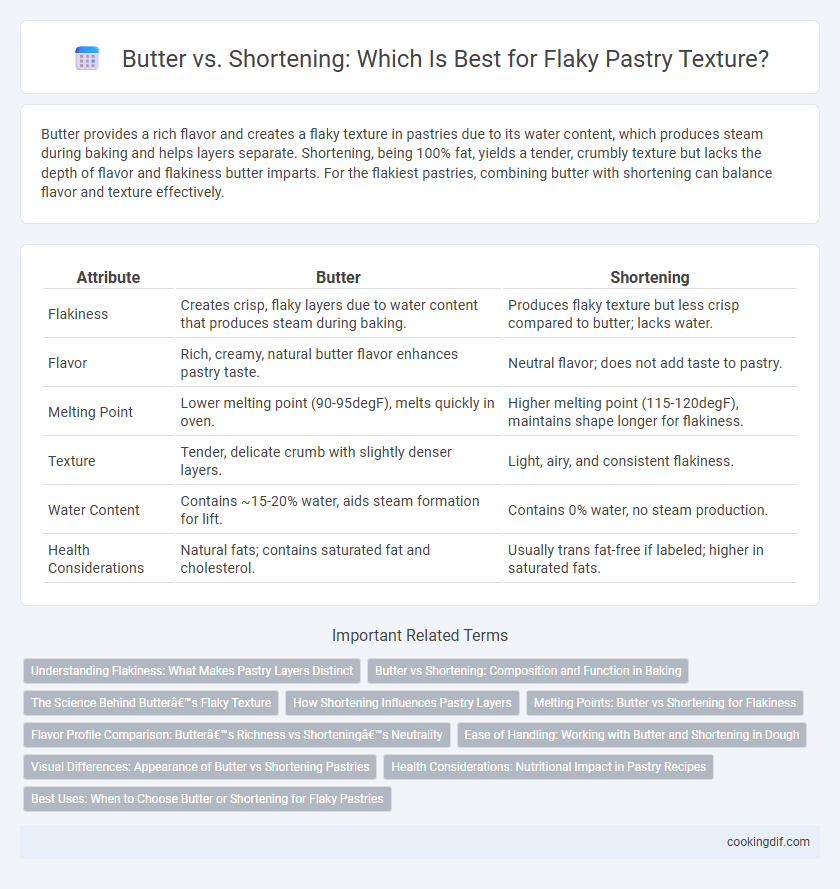Butter provides a rich flavor and creates a flaky texture in pastries due to its water content, which produces steam during baking and helps layers separate. Shortening, being 100% fat, yields a tender, crumbly texture but lacks the depth of flavor and flakiness butter imparts. For the flakiest pastries, combining butter with shortening can balance flavor and texture effectively.
Table of Comparison
| Attribute | Butter | Shortening |
|---|---|---|
| Flakiness | Creates crisp, flaky layers due to water content that produces steam during baking. | Produces flaky texture but less crisp compared to butter; lacks water. |
| Flavor | Rich, creamy, natural butter flavor enhances pastry taste. | Neutral flavor; does not add taste to pastry. |
| Melting Point | Lower melting point (90-95degF), melts quickly in oven. | Higher melting point (115-120degF), maintains shape longer for flakiness. |
| Texture | Tender, delicate crumb with slightly denser layers. | Light, airy, and consistent flakiness. |
| Water Content | Contains ~15-20% water, aids steam formation for lift. | Contains 0% water, no steam production. |
| Health Considerations | Natural fats; contains saturated fat and cholesterol. | Usually trans fat-free if labeled; higher in saturated fats. |
Understanding Flakiness: What Makes Pastry Layers Distinct
Butter contributes to flakiness in pastry by melting at body temperature, creating steam that forms distinct layers as the dough bakes. Shortening has a higher melting point, which helps maintain structure but results in less pronounced layers, producing a tender but less flaky texture. The water content in butter also facilitates steam generation, essential for the characteristic rise and separation of pastry layers.
Butter vs Shortening: Composition and Function in Baking
Butter contains about 80% fat and 15-18% water, contributing to rich flavor and steam production that creates flaky pastry layers. Shortening is 100% fat, providing a higher melting point which results in tender, crumbly textures but less distinct flakiness. The water content in butter generates steam during baking, essential for the lamination process, while shortening's lack of water limits steam formation, affecting the final texture and mouthfeel.
The Science Behind Butter’s Flaky Texture
Butter's water content creates steam during baking, causing pastry layers to puff and separate, resulting in a flaky texture. The fat's melting point allows it to solidify quickly, forming distinct layers that contribute to tenderness and flakiness. In contrast, shortening's lack of water and higher melting point produce a tender but less flaky crust.
How Shortening Influences Pastry Layers
Shortening contributes to a flakier pastry texture by creating distinct, separate layers through its ability to remain solid at room temperature, which inhibits gluten development and prevents excessive moisture absorption. Its high melting point allows the fat to stay in small, discrete pockets during baking, resulting in tender, crisp layers that are more pronounced than those achieved with butter. Unlike butter, shortening does not contain water, making it less likely to cause dough shrinkage and promoting consistent lamination throughout the pastry.
Melting Points: Butter vs Shortening for Flakiness
Butter, with a melting point between 90-95degF (32-35degC), melts quickly in the oven, creating steam that helps form flaky pastry layers. Shortening, melting at a higher temperature of around 115-120degF (46-49degC), remains solid longer during baking, resulting in a different texture that is tender but less flaky. The lower melting point of butter is key to achieving the distinct flaky texture prized in pastries, as it encourages steam pockets to puff up the dough.
Flavor Profile Comparison: Butter’s Richness vs Shortening’s Neutrality
Butter imparts a rich, creamy flavor to pastries, enhancing the overall taste profile with its natural dairy notes. Shortening offers a neutral flavor that allows other ingredients to shine without adding any buttery richness. Choosing between butter and shortening depends on whether a pronounced buttery taste or a more subtle, clean flavor is desired in the final flaky texture.
Ease of Handling: Working with Butter and Shortening in Dough
Butter offers a natural flavor and creates flaky layers but requires careful temperature control to prevent melting and stickiness during dough handling. Shortening remains solid at room temperature, making it easier to work with and less sensitive to heat, which results in more consistent dough manipulation. Incorporating butter demands a delicate touch and rapid processing, while shortening allows for more forgiving handling and less risk of overworking the dough.
Visual Differences: Appearance of Butter vs Shortening Pastries
Butter pastries exhibit a rich golden color and slightly uneven, flaky layers due to butter's water content creating steam during baking. Shortening-based pastries present a paler, more uniform appearance with a tender, dense texture lacking the deep browning and crispiness butter provides. The distinct color and surface texture serve as key visual indicators differentiating butter from shortening in flaky pastry products.
Health Considerations: Nutritional Impact in Pastry Recipes
Butter provides a rich flavor and contributes to a flaky texture due to its water content, which creates steam during baking, but it also contains saturated fats and cholesterol that can impact heart health. Shortening, made from vegetable oils, is typically trans fat-free and has a higher melting point, producing a tender, flaky crust while often containing less saturated fat than butter. Choosing between butter and shortening depends on balancing desired texture with nutritional goals, as butter offers natural ingredients and flavor but higher saturated fat, whereas shortening may aid in lower saturated fat intake but lacks the rich taste of butter.
Best Uses: When to Choose Butter or Shortening for Flaky Pastries
Butter creates a rich flavor and tender, flaky layers in pastries due to its water content that steams during baking. Shortening lacks water and melts at a higher temperature, producing a lighter, more tender crust with less shrinkage, making it ideal for pie crusts requiring a delicate texture. For flaky pastries needing both rich taste and superior structure, blending butter and shortening offers the best balance of flavor and optimal flakiness.
Butter vs Shortening for flaky texture Infographic

 cookingdif.com
cookingdif.com